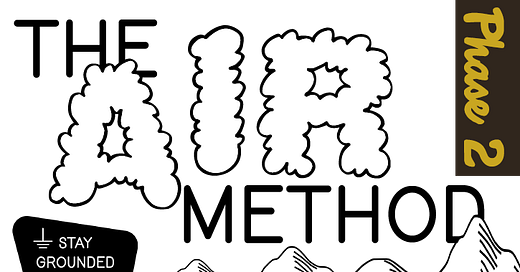The AIR method - Phase II (Part II)
Establishing boundaries between your phone and real life.
This part of phase II is about preventing your phone and it’s apps from reaching out of the device and into your life. It’s about building and enforcing boundaries.
Give your mind at least the chance to relax and enter it’s creative mode. At this part of the journey it won’t happen often, but it can’t happen at all unless the interruptions into your life are stopped.
Turn off/silence notifications
Set up “wind down” mode before bed
Charge phone away from your bed
Set up a “Digital well being” or “App limits” timer
5 - Turn off/silence as many notifications as possible.
The most insidious thing apps do is actively try to distract you and trick you into opening them when you’re doing something else. Let’s be honest- you’re probably checking your phone every 5-10 minutes anyway, you’re not going to miss anything important by turning off notifications.
For apps you’d like to be notified on eventually (email, etc), make the notifications silent, but still visible in the notifications bar. You’ll see it next time you unlock the device.
For the most addictive apps, try turning off push notifications altogether. You’re probably going to be opening that app very soon anyway. Do you really need to be instantly notified every time someone reacts to a story?
Even a desired notification (For example, a call or text) can cause you to see a notification from a “junk food” app and get sucked in.
6 - Set up a “wind down” mode before bed:
Depending on the level of addiction, this step might be harder. But getting good sleep is critical to preventing that burnt-out feeling that causes backsliding and the cyclical anxiety loops.
Turn the screen amber at sunset (Android: “Night Light”, iOS: “Night Shift”)
Studies show that exposure to blue light can prevent your body from inducing sleep.
Grey scale an hour before you usually go to bed.
Grey scale not only makes scrolling apps like Instagram/TikTok more boring, it serves as a subtle reminder that bed time is coming soon.
Silence all notifications (or turn your phone off) at bedtime.
7 - Charge your phone away from where you sleep
There are two benefits to this: one is re-learning to fall asleep without the distraction, the other is giving your mind a chance to wake up naturally at it’s own pace before it gets bombarded with information from the web.
It will take some time to get used to, but blocking your device from interfering with your sleep is very important. Good sleep is the single most important factor in having a healthy and clear mind. Don’t beat yourself up if you find it difficult at first, your body will get past it quicker than you might expect.
8 - Set up a timer on your “junk food” apps
Do you have the app times you wrote down in phase one? Here’s where we use them:
Figure out the average time/day you’re spending on “junk food” apps. (Keep the “whole grain” apps limitless for now)
Set the “Digital well being” or “App limits” timer to ten minutes ABOVE your average use.
The idea for now is just getting used to having the timer around. It’s extremely important you do not allow yourself to perceive the timer as an obstacle or irritation. It is the single most helpful tool at your disposal and if you come in too aggressively you can ruin it’s benefit.
Give yourself some time (a month at least) to get used to having the timer around. If you find you’re hitting the limit every day, increase the limit until you’re only hitting it about once per week. Remember- not rushing through these steps is important.
When the timer warns you that you’ve reached your daily limit, you want your initial reaction to be gratitude for it’s help, not irritated at the impedance. If you are getting irritated every time, increase the timer a little.
When you’ve gotten used to all the phone changes, and having the timer around, you’re ready for Phase III, where the real changes can begin.






